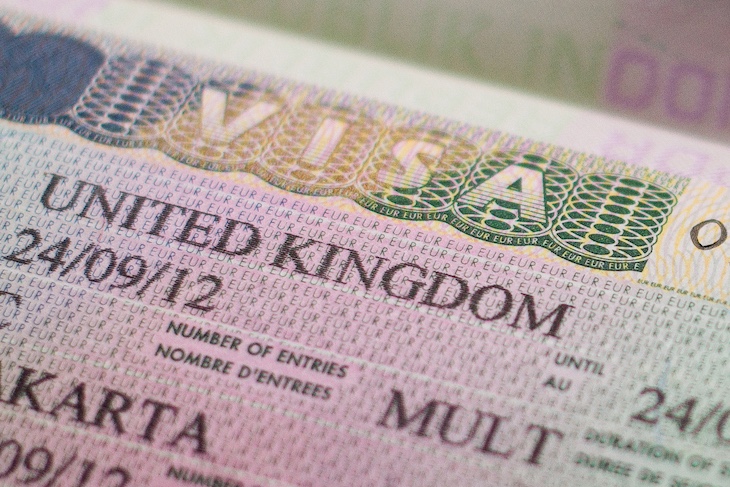A few years ago, a conspiracy theory was born, based on the idea that the population of Britain was far larger than the government claimed. This was known to be true because receipts from Tesco, the country’s largest supermarket, gave an indication of how many people were buying everyday necessities, and these sales were too high to be explained by the official figures.
This supermarket conspiracy of Tesco truthers was mostly covered as entertainment, and Buzzfeed even did a de-bunking, lamenting ‘Rather than trusting the official stats which place the UK population at 64 million, this band of Ukip-ers, conspiracy theorists, and other assorted migration obsessives are adamant that you can really tell the UK population from the amount of food bought – and the amount of sewage which goes out the other end.’
Britain is a surveillance state, but one where the authorities are clueless about who comes in and out, and where they end up
Twenty million extra people clearly sounds implausible but, as with many conspiracy theories, there is a hard version and a soft version, and the idea that the real population is much higher than stated is not only plausible, but likely – and with significant consequences for most public services.
When Britain broke with the EU after the 2016 vote, one of the most pressing issues that arose was the status of the three million EU citizens living here without settled status. A pressure group, the3million, was set up, presumably choosing the figure to show how many people’s lives would be turned upside down.
Except that there weren’t three million unsettled EU citizens here – the figure was actually 5.7 million, of whom 3.8 million now have settled status and another 1.9 million are in the process. It’s welcome news that, for most at least, the hassle and drama is over, yet it does pose the worrying question: how could the government’s population estimate be out by literally millions of people?
Then, during the vaccine roll-out, the National Immunisation Management System (NIMS) estimated that the adult population of England was 49.7 million, rather than the Office for National Statistics (ONS) figure of 44.5 million. It’s hard to exactly know which figure is more accurate, because younger people tend to be quite mobile, less likely to be vaccinated, and unlikely to suffer hospitalisation from Covid, but the variation is huge at any rate.
More recently, NHS records found there to be 63 million registered GP patients in England as of September 2024. Yet the population of England was 56 million in the 2021 census, and only 57 million in 2022, according to the Office for National Statistics. Even if you factor in net migration since then – 764,000 in 2022 and 685,000 in 2023 for the whole of the UK – that doesn’t add up.
With GPs dealing with six million more patients than there are people, fraud is suspected, since doctors may be claiming extra money for non-existent patients. However, a formal investigation by the NHS fraud regulator was abandoned during Covid, as there were obviously more pressing issues, so we don’t know.
It could be fraud, but perhaps not. This week, for example, it was revealed that more one in a hundred people in Britain is an illegal immigrant, a higher proportion than in any European other country, with an estimated 745,000 living here illegally.
Illegal migrants do not have to declare their status while registering with GPs, although the government encourages foreign nationals to do so, so that they might be charged. Although I would rather that all non-citizens be required to take out health insurance while resident here, I agree that healthcare professionals should not look into the status of patients, since the fear of deportation would lead some people to avoid treatment, resulting in avoidable deaths.
But if you had to take a headcount, based on whether people were likely to honestly fill out a census, or register with a doctor free of charge, I would imagine that the latter gave a more accurate picture.
But the truth is – we just don’t know. In fact, everything is a mystery. In November last year, for example, ‘the Home Office admitted it does not know the whereabouts of more than 17,000 asylum seekers whose claims have been discontinued.’
When Lee Anderson asked Home Office officials how many people arriving on small boats had been returned, they didn’t know either. ‘The big boss hasn’t got a clue’, he concluded.
Tory MP Neil O’Brien found that even the Migration Advisory Committee was ‘unable to estimate how many graduate visa holders leave the country before their visa expires, and the Home Office is currently unable to supply this data. O’Brien has been pushing for greater transparency on immigration data, which the authorities seem reluctant to give.
If this all seems odd, then consider how Britain actually records people who come in and out of the country. Until the pandemic, we did so by hiring people to stand around asking random travellers, as the BBC explained.
For 362 days a year, IPS staff leap in front of travellers at 19 airports, eight ports and the Channel Tunnel rail link. They ask them for a bit of their life story: where they’re from, why they’re in the UK and how long they might be staying.
Up to 800,000 people a year take part and about 250,000 of those results are put through the statistical mixer to come up with an estimate for the number of people either arriving to live in the UK, or leaving the UK for at least a year – the internationally-agreed definition of a long-term migrant.
But the IPS doesn’t cover all the ports, all of the time. In Dover there are up to 51 ferry arrivals a day – and the IPS only covers four days’ worth of them over an entire year. The nationwide sample works out at just over 1 per cent of Heathrow’s annual traffic of 78 million people.
According to the Sea Venture Substack, ‘between 2015 and 2017 at least 601,000 people expected to subsequently leave never had an exit recorded. The government simply couldn’t say whether they went home or not. You might imagine (we have a hostile environment policy, after all) that this would trigger vans of burly immigration officers banging on doors. In fact, no attempt at all was made to even contact them.
‘Ignore whatever Home Secretaries and NGOs say about deportations: not only do we not look for overstayers, we often don’t know they exist. In the same time period 201,000 different people were picked up on exit checks who we didn’t know were actually here until they flew out.’
As one of the smartest Twitter accounts explains, Britain is unusual in:
‘not having an ID system. There is no central register of residents or citizens. People prove their identity through random documents (driving licences, utility bills), and businesses check against incomplete databases (especially credit rating agencies). The UK does not systematically collect data on people entering and leaving the country. Many regular border crossings aren’t centrally recorded. To be clear: unless you fly in, it’s perfectly possible to cross the British border undetected. This is particularly true of sea and rail. A Blair-era attempt to fix this (eBorders) was abandoned in 2014. The British government is simply uninterested in the problem.
On a statistical level, there is even more confusion. The Office for National Statistics uses an incredibly dated methodology to estimate net immigration: standing at the airport asking random travellers if they plan to stay in the UK… The ONS write at length defending their methods, but underlying it is the assumption that people will reply accurately to a letter from the government asking them to list everyone living at an address. Which in modern Britain just isn’t plausible. Housing and immigration policy give many people in the UK a strong incentive to misrepresent their residency, in a way that can only be picked up on anecdotally, or when forced into the open by a freak event.’
He concludes by asking ‘what would a country that undercounted its population look like? You’d see higher than expected pressure on public services, housing, and infrastructure. It would seem to be inexplicably poorer than its GDP per capita.’
You would, for example, have a large problem with Dickensian slums, with landlords packing up to 40 people into four-bedroom houses. You would have scenes of overcrowded squalor becoming common. You would have people living in sheds and garages along the back streets of suburban London.
You’d have a shadow world of which the authorities, and the middle class, were largely unaware of until unexpected events brought them to their attention. This became apparent after the Grenfell tragedy, in which dozens of people died while living in unsafe social housing within a short walk from some of the most luxurious streets in Europe. The state had little idea of who actually lived in Grenfell, because subletting is so common. Since that awful event, no fewer than 14 people have been convicted of fraudulently claiming to have lived in the block of flats, with just a few examples found here, here, here, here and here.
Britain is a surveillance state, but one where the authorities are clueless about who comes in and out, and where they end up. Conspiracy theories are clearly not healthy, but they tend to grow in the absence of clear and honest information.
Tony Blair was right: ID cards are clearly needed
Census-taking is one of the older functions of a government, after tax-raising, law and order and border enforcement. Even the Roman Empire, far less sophisticated than modern states, had a rough idea of who lived inside its borders. We often hear Christian leaders telling us that we should welcome illegal immigrants because the Holy Family, too, were refugees, but at least Joseph and Mary took part in the census.
Britain’s population is growing very quickly, and this is now almost entirely down to immigration. Last year, half a century after the country entered sub-replacement fertility, deaths exceeded births for the first time in Britain, and that process will only accelerate.
According to some estimates, about 3.6 per cent of the entire population of Britain have only arrived in the past two years. To put that in context, our history books often cite the Huguenots as an example of Britain’s history of immigration, and they accounted for about 1 per cent of the population.
But it’s also a problem that we simply don’t know who is coming in and out, which means that we are unable to prevent criminals sneaking back into the country or even getting jobs with the NHS.
This was recognised as a problem by Tony Blair, who tried to introduce ID cards, an idea abandoned by the Conservatives in the face of civil liberty objections both from the right and left, as well as cost issues.
I used to be against ID cards, mainly for irrationally reactionary vibes reasons – we didn’t have them in 1913 when, as AJP Taylor put it, an Englishman’s only contact with the state would be the Post Office and local policeman. Plus, Tony Blair was in favour – what other arguments do you need? But Blair was right, and ID cards are clearly now needed.
The new e-visa system should mean that we have a better idea of who has entered and exited the country, but as with so many aspects of anarcho-tyranny, it will only work in recording those who play by the rules.
Back in 2010, the Balanced Migration group warned that the population would hit 70 million around 2030, a projection based on the belief that the Tory party would reduce net migration. The official figure for the entire United Kingdom from the 2021 census was 67 million, but I would be very surprised if it wasn’t over 70 million already. What is the actual population? We clearly don’t know. Indeed we almost certainly have less idea than authorities taking the first census back in 1841, when Dickens’s accounts of slum overcrowding first began to prick middle-class consciences.
Watch more on Spectator TV:
This article first appeared in Ed West’s Wrong Side of History Substack.








Comments